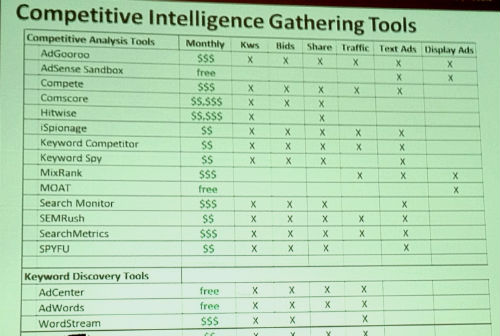 SES Toronto was full of great content from the keynote from Avinash Kaushik where he took local companies to task with their search visibility and user experience to breakout sessions like the content marketing optimization panel I presented on and this one: Spy vs. Spy: Competitive Analysis. There’s a plethora of tools available online to track, monitor and uncover information that could be used to gain a competitive advantage for both organic search optimization and pay per click.
SES Toronto was full of great content from the keynote from Avinash Kaushik where he took local companies to task with their search visibility and user experience to breakout sessions like the content marketing optimization panel I presented on and this one: Spy vs. Spy: Competitive Analysis. There’s a plethora of tools available online to track, monitor and uncover information that could be used to gain a competitive advantage for both organic search optimization and pay per click.
This session provided a balance of both and included speakers Jim Yu of Bright Edge (@brightedge) and Matt Van Wagner (@mvanwagner) of findmefaster. Moderation duties were handled by Mike Grehan (@mikegrehan), Global VP Content, SES, Search Engine Watch, ClickZ.
Starting things off was Jim Yu of BrightEdge, which is an enterprise SEO platform that has over 2,000 brands using their product.
In 2012 BrightEdge did a study of 300 clients to ask what some of the big drivers had been for SEO. Brands are starting to understand and see the business impact of SEO being able to drive lift and tie that back to revenue and metrics. Companies are also realizing that SEO is a “winner take most” situation. Those on top take the vast majority of attention and traffic.
To make sense out of SEO for a business and the competitive analysis that’s involved with understanding your SEO market is to have a framework for competitive analysis.
Know your competitors in search. There are direct competirors in the world, but in search competitors are different: they can include other content sources that do not sell similar products or services. How to know your search competitors? Do so through groups of keywords.
- Identify a group of related keywords and analyze them
- Run them through the Google AdWords keyword tool. Look at exact match phrases
- Take the top 10 ranking pages for those keywords
- Build a model to forecast share of voice = SUM for keywords (search volume x click-through)
This allows you to identify search-specific competitors.
1. Break down their strategy and tactics
Take each of the pages that are ranking and build a spreadsheet grouped by domain. Capture the on-page factors and analyze the number of links pointing to each page. Look at the social engagement for each page. (Tweets, Likes and Shares).
Figure out structurally, how those companies are going after the keywords that you’re also going after.
2. Undersand on-page tactics
Title tags, meta description, on-page headers, body text
Look for the related keywords that each page ranks on. Understand the site structure and page types they are using to go after different types of keywords.
3. Assess their link strategy
Look at high value link targets. Identify link hubs that are driving rankings for this market segment. Also identify link strategies. Classify link s based on type: blog, news, PR, partnerships, social)
4. Measure their social signals. Collect signal counts for pages you are looking to outrank.
Core SEO Competitive Analysis Framework:
- Competitors share of voice
- On page attributes
- Back links
- Social signals
If you think SEO is a competitive market, take a look at PPC and you’ll see a whole new universe of healthy marketing budgets jockeying for position. With SEO there are far more variables at play but with Paid Search, a lot more money is at stake in terms of what companies are investing. The disparity between marketing budget allocation between SEO and PPC is worth an entirely different blog post of course.
Suffice it to say that Matt Van Wagner’s presentation about paid search competitive analysis ran the full gamut of considerations on not only finding out what PPC competitors are doing but using PPC information to find competitive information about a company overall.
Study your competitors: What are they doing now, likely to do and when they will likely do it? Also understand competitor strengths and weaknesses. “Eat their lunch before they eat yours”.
PPC competitive analysis can be used for benchmarking, forecasting and forensics that uncover things that can be reported to the search engines. Go beyond the obvious questions such as, “What keywords are they buying?, “Why are they always positioned above us?”, “How much are they bidding?”. Instead, ask more strategic questions like: “How big is our opportunity?”, “How profitable are our competirors?”, “How much more can we invest in paid search?”.
How to study PPC competitors: There are a variety of tactics you can use to study paid search competitors including: text ads, display ads, landing pages, tracking/analytics, scheduling and habits.
Answer questions about current status:
- “How many ads are they running?
- How many different messages and offers are there
- Are they using best practice?
Dig into their testing and ad rotation.
- Are they testing ads now?
- How often do they present new ads?
Check into their responsiveness:
- Do they react to bid changes or new ads?
- How quickly?
Learn from your competitor websites by looking at destination URLs and landing apges. Use forensic intelligence to find bad behavior such as: ad double serving, illegal trademark use in ads, not playing by the rules, quality score sniffing and duplicating your content.
Tools and resources:
- DomainTools.com
- Link Analysis Tools: SEOmoz, Majestic SEO, Squid, AdGooroo Link Insight and link:yoururl.com
- Search on competitor URL and search phrases
- Setup Google news alerts on competitor names
- Keep an eye on Twitter
- Read SEC filings
- Watch their conference presentations
Matt gave a few examples of interesting and useful things he’s found my engaging in general competitive analysis:
- Competitors preparing a whole new website – discovered through link analysis
- Profitability on paid search – found via press releases
- Corporate priorities and investment – found through SEC 8k/10k filings
- Allegations of board room romances and double crossing – discovered from online lawsuit documentation
While there’s an incredible amount of competitive information online, Matt suggests that we don’t obsess on competitors and focus more on bettering ourselves. Be aware of intelligence limitations and blind spots such as manual searches on keywords and geographical ad presentation.
Matt finished things up with a grid of competitive intelligence gathering tool:

What are you doing to spy on your competitors and are you doing anything to make it more difficult for them to spy on you? This was the inspiration for the title of the session although the focus was more in the act of spying. Perhaps by understanding how others can collect information on your SEO and PPC activities you can be more defensive as well practicing good offense when it comes to competitive analysis.


